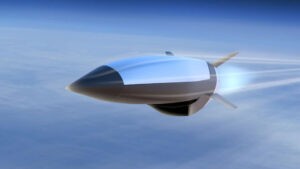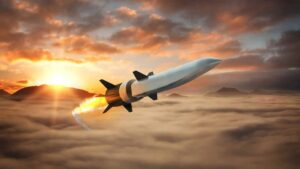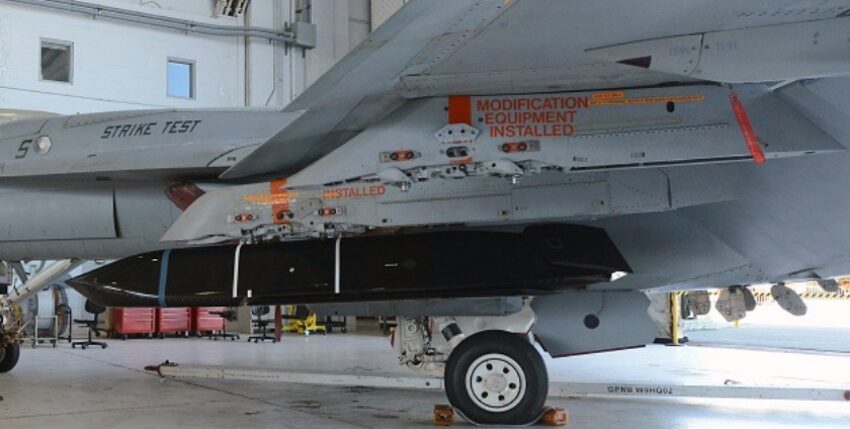The American armed forces are lagging behind the Russians in the development of hypersonic weapons. A development programme has now been initiated for the Navy's fighter-bombers.
On 27 March, the US Navy commissioned rival companies Raytheon and Lockheed Martin to develop an aircraft-carrier-capable hypersonic cruise missile to combat sea targets. The development programme is called Hypersonic Air-Launched Offensive Anti-Surface Warfare Weapon or Halo for short.
Halo is not to be deployed directly from the ship, but from carrier-based fighter aircraft, in particular the F/A-18E/F. The Navy expects Halo to be too large to be carried in the internal armoury of the F-35C fighter-bomber. Although this aircraft should be able to carry the cruise missile externally, this would compromise the stealth characteristics of the aircraft. The new weapon is intended to combine the speed of ballistic missiles with the sustained manoeuvrability of cruise missiles. These characteristics should enable the hypersonic missile to considerably reduce the enemy's warning time and significantly reduce their defence options.
To be considered a hypersonic weapon, the missile would have to fly at least five times the speed of sound. Despite its official designation as hypersonic, Halo is likely to fall just short of this target, explained Rear Admiral Stephen Tedford, the programme director responsible for airborne offensive weapons. "From a speed standpoint, the Halo designation is a little misleading," he said during this year's Navy League Sea-Air-Space Symposium in Maryland. "Mach 5 isn't the deciding factor for us either. It's about range and time. Can we cover the desired distance as quickly as possible? The maximum flight speed will probably be in the upper Mach 4 range. However, our main focus is more on whether we can fly to the target quickly enough so that we don't have to update the target coordinates during the flight."

The operational range has also not yet been finalised. Nevertheless, Halo is categorised as a long-range offensive weapon (Navy Long-Range Fires). The flight distance is therefore likely to exceed the range of the sea-based missiles currently carried by the F/A-18. The most powerful air-launched anti-ship missile currently available is the AGM-158C LRASM (Long-Range Anti-Ship Missile). This long-range anti-ship missile was only introduced into the fleet in December 2019, where it is deployed by the F/A-18. The AGM-158C has a range of more than 200 nautical miles and flies in the subsonic range.
Ramjet or scramjet?
The exact type of propulsion for the Halo cruise missile has not yet been determined. In principle, the required power could be provided by a ramjet or a supersonic combustion ramjet (scramjet). In addition, Halo will in all probability have to be equipped with a tail-mounted booster rocket, as the main propulsion system of such missiles - especially in the case of the scramjet propulsion system - only ignites after reaching a high flight speed. In any case, this configuration would correspond to the hypersonic cruise missile concepts previously designed on behalf of the Pentagon.
However, the Pentagon has not issued any guidelines in this regard. "Whether scramjet or ramjet, we have no preference," explained Admiral Tedford. "We're all about performance." In view of the fact that the Navy wants to have an operational weapon by 2029, the admiral assumes that the missile will be based on existing technology. The Navy and the contracted companies will also be able to draw on knowledge and technologies gained in the course of weapons research and development by the other branches of the armed forces. This includes the airborne Hypersonic Attack Cruise Missile (HACM) for the US Air Force. Raytheon was awarded the contract for the series development of this weapon system in 2022, which is due to enter service in 2027.
Increasing operational demand
The new weapon is being developed under the supervision of the Naval Air Systems Command (Navair), which is responsible for air systems. According to the command, the hypersonic missile is required to compensate for the increasing performance of enemy combat systems. These include better enemy sensors for the early detection of approaching aircraft and cruise missiles, anti-aircraft weapons to combat aircraft and missiles and electronic warfare systems to protect enemy ships from ballistic missiles and cruise missiles. The introduction of long-range and very fast sea-target missiles for potential opponents also increases the need to be able to preemptively neutralise enemy ships as quickly as possible in the event of war. The technological and quantitative armament of Russian and Chinese naval forces is at the centre of American planning.

and Northrop Grumman together
for the US Air Force, graphic: Raytheon/Northrop Grumman
According to the programme office, Halo is to be used primarily in littoral waters and in the so-called A2/AD zones (Anti-Access/Area Denial), where conventional aircraft and weapon systems can only operate to a limited extent due to an enemy defence belt. The weapon will also be used against time-critical targets, such as high-value ships, which in turn would be capable of firing precision weapons, including hypersonic weapons and so-called aircraft carrier killer missiles, at American or friendly forces. The US Navy intends to use hypersonic weapons to determine the pace of battle and limit the enemy's ability to react, according to a statement from the responsible Navair programme office.
Programme schedule
The tender for the Navy Long Range Fires programme, which is now leading to the development of the Halo weapon system, was issued in 2021. The contracts awarded at the end of March have a cumulative value of 116 million dollars and apply to the first phase of the development programme; the Pentagon did not disclose whether the funds will be distributed evenly among the applicants. This phase of the project will run until the end of 2024, during which time the two companies will develop initial designs of the weapon system and ensure the technical maturity of the overall concept and major components. The main focus will be on developing the propulsion system and demonstrating the operational readiness of the propulsion system. Following the critical design review scheduled for the end of 2024, the prototype phase will begin. Between 2024 and 2028, the Navy plans to invest a further 450 million dollars in the development and testing of Halo.
After thorough testing of the prototypes in the wind tunnel and ground tests of the propulsion system, flight testing is scheduled to begin in 2026. The operational introduction of Halo is scheduled for 2029. According to Admiral Tedford, the Navy is expected to acquire around 800 of the hypersonic cruise missiles.
Sidney E. Dean










